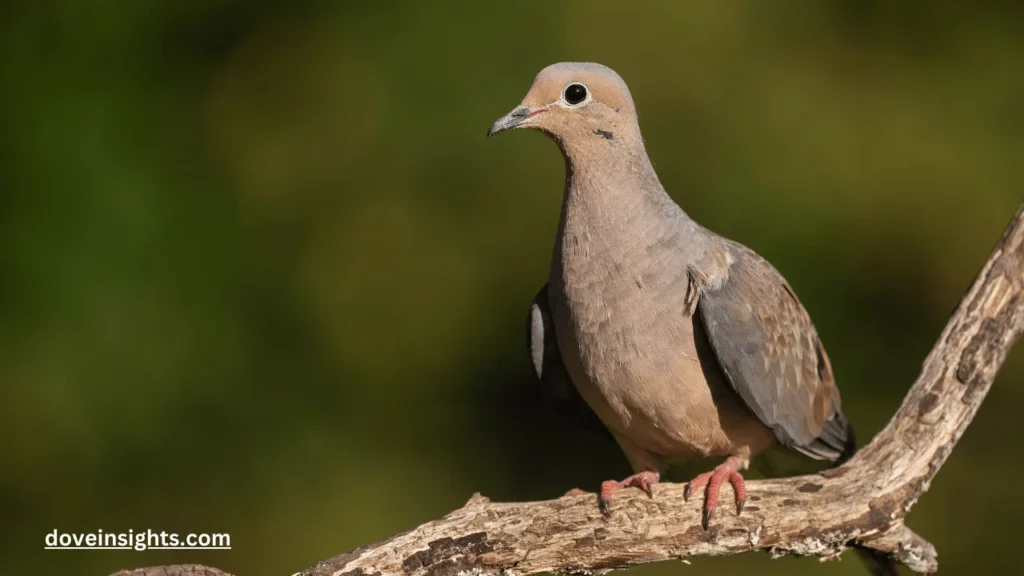Imagine walking through a quiet park and spotting a pair of doves perched delicately on a branch, cooing softly.
While these birds are often associated with peace and harmony, there’s more to them than meets the eye, especially when it comes to their nesting habits. Have you ever wondered where doves build their nests, or how they construct them? Unlike other birds that create intricate, elaborate nests, doves are known for their simple yet effective approach to nesting.
But how much do we really know about their nesting behavior? Do doves build their nests in the same way that sparrows or robins do, or do they have their own unique process?
The answer to whether doves build nests is not as straightforward as it may seem. While many people are familiar with the sight of doves on tree branches or rooftops, few realize that their nest-building methods are often quite different from other birds.
Doves create relatively simple nests, usually composed of twigs and other lightweight materials, but there is a fascinating intricacy to their selection of nesting sites, materials, and even their roles in raising offspring.
Understanding how doves build nests offers insight into their behaviors and their adaptation to both natural and urban environments.
This article explores the nest-building habits of doves, examining the materials they use, the locations they choose, and the fascinating process by which they raise their young. By diving deeper into how doves create their homes, we gain a better appreciation for these beautiful birds and their role in the ecosystems they inhabit.
Whether you’re a nature enthusiast or just curious about doves, you’ll find that their nesting behavior is more captivating than you might have expected.
Contents
The Importance of Nesting for Doves
Before we dive into how doves build their nests, it’s essential to understand why nesting is so important for them. Nesting is a crucial part of the reproductive process for all birds, but it holds particular significance for doves.
The nest serves as a safe space where doves can lay eggs, incubate them, and raise their young in relative safety from predators and harsh weather conditions. Unlike some other species, doves typically reuse their nests year after year, adding and repairing them as needed.
For doves, nesting is not only about creating a secure environment for their offspring; it is also about securing a location that will attract mates. During the breeding season, male doves often display their nests as a sign of their suitability as a mate.
This leads us to the next point—doves do not just build any nest; they build strategic nests that help them in the mating process and ensuring their lineage.
How Doves Build Their Nests
Doves are not known for constructing the most elaborate nests. Their nests are simple, often just a loose arrangement of twigs and sticks.
Male doves typically start the process by finding a suitable site, usually in high, sheltered places such as trees, ledges, or even the tops of buildings. They use their beaks and feet to arrange sticks and twigs into a basic structure, often working together with their mates to build the nest.
Unlike some birds that create tightly woven nests with intricate designs, doves construct their nests by placing the twigs loosely together, forming a shallow cup.
The resulting nest is not built for strength but rather for function. The main goal is to create a safe, stable platform where eggs can be laid and the young can be kept warm and protected.
Doves often choose elevated sites for their nests to reduce the risk of predators like squirrels, snakes, or other birds. Urban doves may nest on window ledges, balconies, or even signposts, showcasing their adaptability to human environments.
This flexibility is key to the dove’s survival in diverse habitats, from rural forests to bustling cities.
Materials Used in Dove Nests
The materials that doves use for nest-building are simple yet carefully chosen. Doves typically use twigs, sticks, and grass, along with other natural elements such as leaves and feathers.
The twigs are often collected from the ground or nearby shrubs, and doves may even repurpose materials from previously used nests.
Feathers play an important role in dove nesting, as they help to insulate the nest and keep the eggs warm. Soft plant fibers are sometimes added to provide additional comfort for the young doves.
Interestingly, doves are not very picky about the materials they use, as long as they serve the purpose of supporting the eggs and providing a stable foundation. This is in contrast to species like the weaver bird, which builds complex, tightly woven nests.
Doves prioritize ease and simplicity, focusing more on the location and stability of the nest than on its appearance or complexity.
The Role of Both Parents in Nesting
Unlike some bird species where only the female is involved in nest-building and rearing the young, both the male and female dove share the duties of nest construction and egg incubation.
After the male selects a site and begins gathering materials, the female dove often helps arrange the twigs and finalize the nest’s structure. Once the nest is complete, the female lays one or two eggs, and both parents take turns incubating them.
Male doves play an active role in incubating the eggs, especially in the early stages. During this time, they rely on their ability to keep the nest stable and secure. After hatching, both parents work together to feed the chicks.
Doves produce a special secretion called “pigeon milk” to feed their young, a nutrient-rich substance that they regurgitate directly into the chicks’ mouths.
This cooperative parenting style is vital for the survival of the young doves. The parents’ involvement ensures that the chicks are properly fed, protected, and nurtured until they are old enough to fledge (leave the nest) and begin their lives as independent birds.
Dove Nesting in Urban Environments

In urban settings, doves have adapted to human-made structures and have found new ways to build their nests. Instead of traditional tree branches or natural shelters, doves often choose man-made platforms, such as rooftops, balconies, and window ledges.
The abundance of food, water, and sheltered spaces in cities has allowed doves to thrive in environments far removed from their original habitats.
While urban nesting offers safety from certain predators, it also brings challenges. Pollution, human activity, and the risk of nest destruction by maintenance crews or other urban dangers can threaten dove populations in cities.
Despite these risks, doves have proven to be remarkably adaptable, finding new spaces to create their homes and raise their young in even the most congested environments.
Conclusion
So, do doves build nests? The answer is a resounding yes, but in their own unique and adaptive way. Doves may not create the elaborate nests seen in other bird species, but their simple and functional approach to nest-building has allowed them to thrive in a variety of environments.
From their use of natural materials to their cooperative parenting style, doves have honed a nesting strategy that balances efficiency, protection, and adaptability.
As we have seen, the nesting process for doves is both practical and essential for their survival, ensuring the next generation of these beautiful, peaceful birds.
By understanding how doves build their nests, we gain a deeper appreciation for the resilience and resourcefulness of these creatures. Whether in a forest or a city, doves continue to inspire us with their ability to adapt and thrive, making them a symbol of nature’s endurance and beauty.
FAQ’s
Do doves always build nests in trees?
No, doves do not always build nests in trees. While many doves do prefer nesting in trees for safety and stability, they are also highly adaptable and will build nests in urban environments such as balconies, window ledges, and rooftops. In fact, many doves, especially the rock pigeon, are commonly seen nesting on human-made structures in cities, as these locations often provide shelter from predators.
How long does it take for doves to build a nest?
The process of building a dove’s nest is relatively quick compared to other birds. It usually takes about 2 to 4 days for the male and female doves to gather materials and construct a simple nest. The nest itself is made up of loosely arranged twigs and sticks, which they place in a shallow cup shape. The actual time can vary depending on the location and availability of materials.
How many eggs do doves lay in a nest?
Doves typically lay one or two eggs in each breeding cycle. After the eggs are laid, both the male and female take turns incubating them. The incubation period usually lasts around 14 to 19 days, depending on the species and environmental conditions. Once the eggs hatch, both parents share responsibility for feeding and caring for the chicks.
Do doves reuse their nests?
Yes, doves often reuse their nests year after year. Unlike some birds that build new nests for each breeding season, doves typically repair and add to their previous nests. This behavior is especially common in doves that nest in urban environments where suitable nesting sites may be limited. Reusing the nest helps save time and effort in the breeding process, allowing the doves to focus on raising their young.
What materials do doves use to build their nests?
Doves primarily use twigs, sticks, grasses, and leaves to build their nests. They often collect these materials from the ground or nearby vegetation. Feathers are also used in some cases, as they help to provide insulation for the eggs and chicks. The nests are generally simple, with loose twigs arranged in a shallow cup shape.
How do doves protect their nests?
Doves typically build their nests in elevated, sheltered locations to avoid predators such as squirrels, snakes, and other birds. Urban doves may choose rooftops, balconies, or ledges because these locations are often less accessible to predators. While doves are not particularly aggressive when defending their nests, the male dove will often become protective and may display aggressive behaviors if the nest is threatened.








